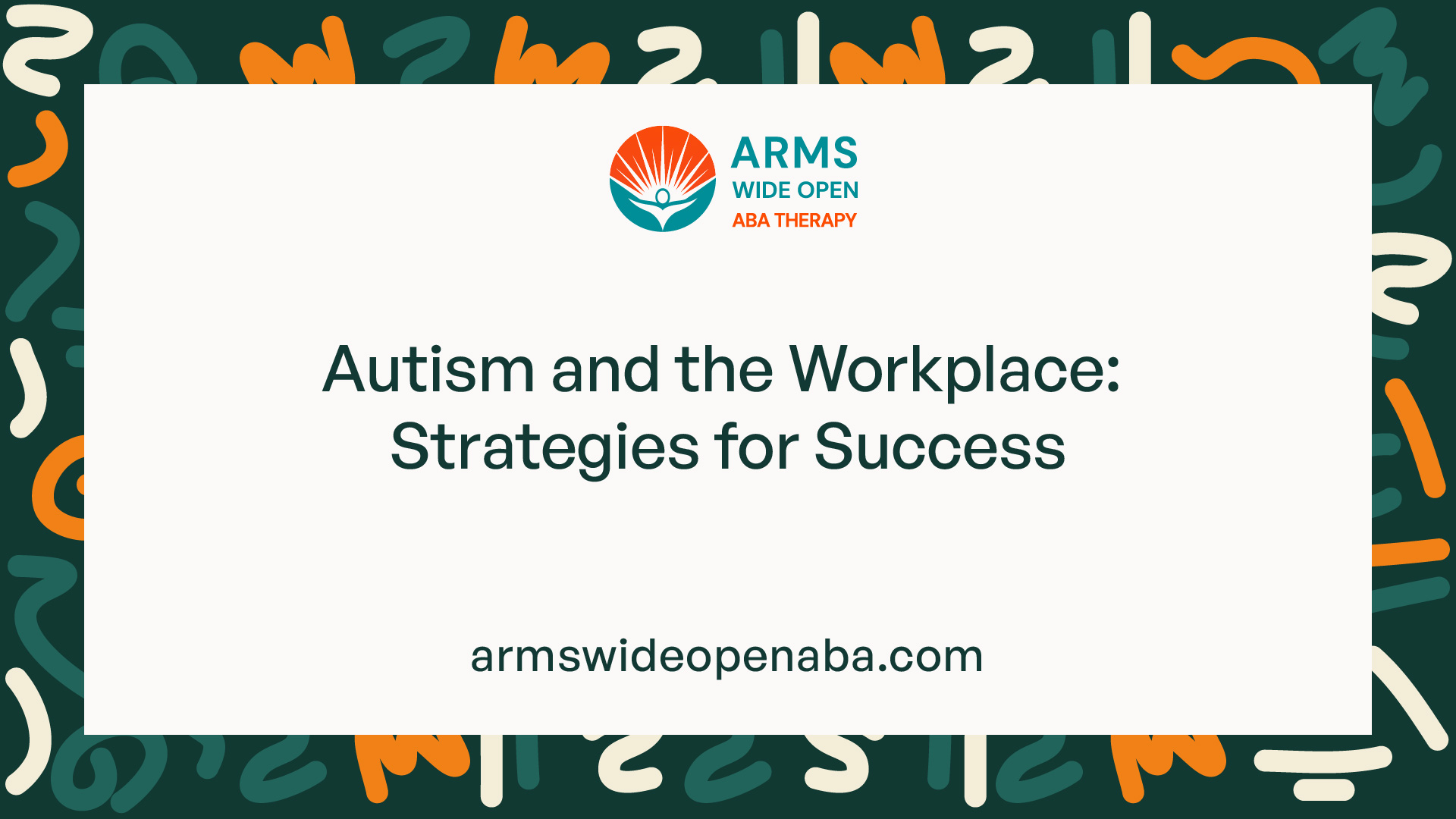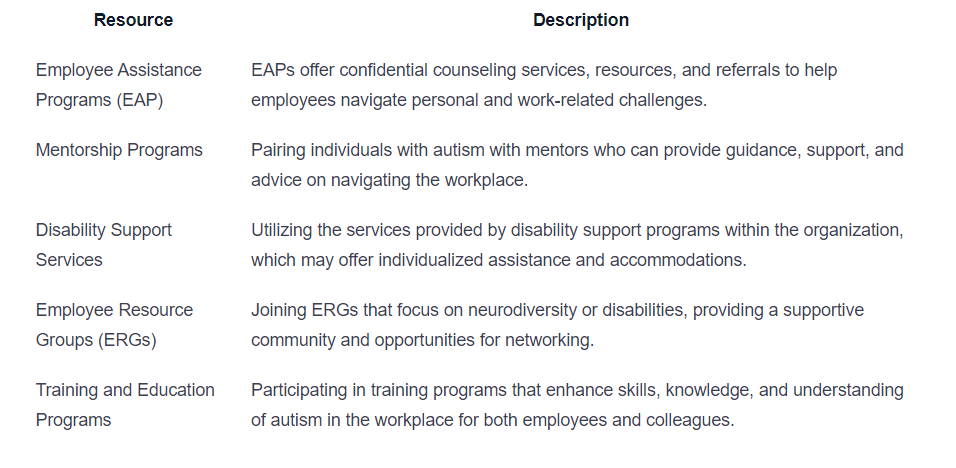Autism and the Workplace: Strategies for Success
Overcoming challenges of autism at work: Strategies, communication, sensory support, and more to navigate the path to success.

Understanding Autism in the Workplace
Autism, also known as Autism Spectrum Disorder (ASD), is a neurodevelopmental disorder that affects an individual's social communication and interaction skills. It is important to understand how autism manifests in the workplace and the challenges that individuals with autism may face.

Autism Spectrum Disorder (ASD) Overview
Autism Spectrum Disorder (ASD) is a complex developmental condition that is characterized by challenges in social interaction, communication, and repetitive behaviors. The spectrum encompasses a wide range of abilities and challenges, which can vary from person to person.
Individuals with ASD may demonstrate a range of strengths and difficulties, including:
- Social communication challenges: Difficulties in understanding and using verbal and nonverbal communication, such as facial expressions, gestures, and tone of voice.
- Restricted and repetitive behaviors: Engaging in repetitive movements or fixated interests, and displaying resistance to change in routines.
- Sensory sensitivities: Heightened sensitivity or aversion to certain sensory stimuli, such as noise, lights, or textures.
It is important to note that individuals with ASD possess unique strengths and talents, such as attention to detail, creativity, and strong memory skills. Understanding and accommodating these strengths can contribute to a positive and inclusive work environment.
Common Challenges Faced by Individuals with Autism at Work
In the workplace, individuals with autism may encounter specific challenges that can impact their job performance and overall well-being. Some common challenges faced by individuals with autism at work include:
Challenges
Difficulty with social interactions and communication
Sensory sensitivities that can be overwhelming in the work environment
Challenges in managing and organizing tasks
Difficulty understanding and adapting to unwritten social norms and expectations
Limited flexibility in handling changes in routine
By recognizing these challenges, employers and colleagues can work together to create a supportive and inclusive environment that allows individuals with autism to thrive and contribute their unique skills and perspectives. Through understanding, empathy, and appropriate accommodations, the workplace can become a place where individuals with autism can overcome challenges and achieve success.
Overcoming Communication Barriers
Effective communication is essential in the workplace, and individuals with autism may face unique challenges in this area. However, with the right strategies, these barriers can be overcome, allowing for improved communication and successful collaboration.
Strategies for Effective Communication
When communicating with individuals with autism in the workplace, it's important to be mindful of their unique communication styles and preferences. Here are some strategies that can foster effective communication:
- Clear and Concise Language: Use simple and straightforward language when conveying information. Avoid using idioms or abstract language that may be difficult to understand.
- Visual Aids: Visual aids such as charts, diagrams, or written instructions can provide additional support for individuals with autism. These visual cues help to reinforce verbal communication and enhance understanding.
- Structured Communication: Establish clear communication routines and structures. This can include using agendas or schedules for meetings, providing advance notice of changes, and allowing extra time for processing information.
- Active Listening: Practice active listening by giving the individual your full attention, maintaining eye contact, and acknowledging their input. Repeat or paraphrase information to ensure mutual understanding.
- Written Communication: Utilize written communication methods such as emails or memos to provide important information or instructions. This allows individuals with autism to refer back to the information as needed.
Building Supportive Relationships with Colleagues
Creating a supportive and inclusive work environment is vital for individuals with autism to thrive. Building positive relationships with colleagues can foster understanding, empathy, and collaboration. Here are some ways to foster supportive relationships:
- Education and Awareness: Educate colleagues about autism spectrum disorder (ASD) to increase understanding and dispel misconceptions. This can be done through workshops, training sessions, or informational materials.
- Encouraging Open Communication: Foster an environment where individuals feel comfortable expressing their needs, concerns, and perspectives. Encourage open dialogue and provide opportunities for everyone to contribute to discussions.
- Team Building Activities: Engage in team-building activities that promote collaboration and social interaction. This can include group projects, team lunches, or social events outside of work.
- Peer Support Programs: Implement peer support programs where colleagues can provide guidance and support to individuals with autism. This can involve pairing individuals with mentors or creating buddy systems.
- Sensitivity and Flexibility: Be sensitive to the unique needs and challenges faced by individuals with autism. Offer flexibility in work arrangements or accommodations when necessary, ensuring equal opportunities for success.
By implementing these strategies and fostering supportive relationships, individuals with autism can overcome communication barriers and feel valued and included in the workplace.
Table: Strategies for Effective Communication
Strategies for Effective Communication
Clear and Concise Language
Visual Aids
Structured Communication
Active Listening
Written Communication
Building Supportive Relationships with Colleagues
Creating a supportive work environment for individuals with autism involves building relationships based on understanding, respect, and collaboration. Here are some ways to foster supportive relationships with colleagues:
- Education and Awareness: Educate colleagues about autism and its characteristics, emphasizing the strengths and unique perspectives that individuals with autism bring to the workplace. This helps to create a more inclusive and accepting environment.
- Empathy and Patience: Foster empathy and patience among colleagues by encouraging them to put themselves in the shoes of individuals with autism. Promote understanding that everyone has different ways of processing and communicating information.
- Active Inclusion: Actively include individuals with autism in team activities, discussions, and decision-making processes. Encourage their participation and value their contributions, fostering a sense of belonging.
- Communication Support: Provide communication supports, such as designated communication channels or platforms, to ensure effective and inclusive communication among all team members. This can include clear guidelines for written and verbal communication.
- Team-Building Exercises: Engage in team-building exercises that promote collaboration, trust, and understanding. These activities can help colleagues build stronger relationships and create a positive work environment.
Remember, building supportive relationships takes time and effort from all team members. By fostering an inclusive and accepting workplace culture, you can create an environment where individuals with autism feel valued, respected, and supported.
Managing Sensory Sensitivities
Individuals with autism often experience sensory sensitivities that can impact their comfort and productivity in the workplace. Understanding and addressing these sensitivities is crucial for creating an inclusive and supportive work environment. In this section, we will explore strategies for managing sensory sensitivities at work, including recognizing triggers in the work environment and creating a sensory-friendly workspace.
Recognizing Triggers in the Work Environment
To effectively manage sensory sensitivities, it is important to first identify the specific triggers that can cause discomfort or distress for individuals with autism in the workplace. These triggers can vary from person to person, but some common examples include:
- Loud noises or sudden sounds
- Bright or flickering lights
- Strong smells or odors
- Busy or crowded workspaces
- Uncomfortable or restrictive clothing
- Certain textures or surfaces
By recognizing these triggers, employers and colleagues can work together to minimize their impact and create a more accommodating work environment. This can involve making small adjustments such as reducing background noise, providing alternative lighting options, or implementing flexible workspaces.
Creating a Sensory-Friendly Workspace
Designing a sensory-friendly workspace is essential for individuals with autism to thrive in the workplace. Consider the following factors when creating an environment that supports sensory sensitivities:

By considering these accommodations, employers can create a workspace that is more inclusive and supportive for individuals with autism. It is important to involve employees in the decision-making process and tailor the accommodations to their specific needs.
Understanding and addressing sensory sensitivities in the workplace is an important step towards creating an inclusive environment for individuals with autism. By recognizing triggers and implementing accommodations, employers can help individuals with autism thrive and reach their full potential in the workplace.
Enhancing Organizational Skills
Individuals with autism often face challenges with organization in the workplace. However, there are various tools and techniques that can help them improve their organizational skills and succeed in their professional endeavors.
Tools and Techniques for Organization
Utilizing the right tools and techniques can greatly enhance organizational skills for individuals with autism in the workplace. Here are some strategies that can be beneficial:
- Visual organizers: Incorporating visual aids such as calendars, to-do lists, and color-coded schedules can provide a clear and structured approach to tasks and deadlines. These visual organizers help individuals with autism stay organized and manage their time effectively.
- Task management apps: Technology can be a valuable asset in improving organization skills. Task management apps, like Trello or Asana, allow individuals to create and manage tasks, set reminders, and track progress. These apps provide a digital platform for organizing and prioritizing work-related responsibilities.
- Workplace accommodations: It's essential for individuals with autism to communicate their needs and seek reasonable workplace accommodations. This may include having a designated workspace, utilizing noise-cancelling headphones, or having a written outline of tasks and expectations. These accommodations can help create a conducive environment for improved organization and productivity.
- Note-taking strategies: Encouraging the use of note-taking strategies, such as color-coding, highlighting key points, or using mind maps, can enhance organization and retention of information. These techniques can be especially helpful during meetings, training sessions, or when working on complex projects.
Establishing Clear Routines and Structures
Establishing clear routines and structures is another effective way to enhance organizational skills for individuals with autism in the workplace. By creating a predictable and structured environment, it becomes easier to manage tasks and maintain focus. Here are some strategies to consider:
- Establish a daily routine: Having a consistent daily routine helps individuals with autism anticipate and plan their workday. This routine can include specific times for starting and ending work, breaks, and scheduled activities. Maintaining a routine helps reduce anxiety and provides a sense of stability.
- Break tasks into smaller steps: Large tasks can be overwhelming, so breaking them down into smaller, manageable steps can make them more approachable. This approach allows individuals to focus on one task at a time, increasing productivity and reducing stress.
- Use visual schedules: Visual schedules or timetables provide a visual representation of the day's activities and tasks. These schedules can be displayed prominently in the workspace, serving as a visual reminder and guide for the day's activities. Visual schedules offer clarity and help individuals stay organized and on track.
- Implement structured work processes: Introducing structured work processes, such as utilizing checklists or following standardized procedures, can enhance organization and efficiency. These processes provide clear guidelines and help individuals with autism stay focused on their tasks.
By incorporating tools and techniques for organization and establishing clear routines and structures, individuals with autism can overcome organizational challenges in the workplace. These strategies promote productivity, reduce stress, and create a supportive work environment conducive to success.
Navigating Social Interactions
Individuals with autism may face unique challenges when it comes to navigating social interactions in the workplace. Understanding social cues and norms, as well as developing social skills specific to the work environment, can greatly contribute to success and a positive work experience.
Understanding Social Cues and Norms
One of the challenges individuals with autism may encounter is difficulty in understanding social cues and norms. This can lead to misinterpretations or misunderstandings during conversations or interactions with colleagues. However, with awareness and practice, it is possible to enhance social understanding and bridge this gap.
To better understand social cues and norms, individuals with autism can:
- Observe and learn from others: Paying attention to how colleagues interact with one another can provide valuable insights into social expectations and appropriate behavior.
- Seek clarification when unsure: If unsure about a social cue or norm, don't hesitate to ask for clarification or guidance from a trusted colleague or supervisor.
- Utilize online resources and training materials: There are various online resources and training programs specifically designed to help individuals with autism navigate social situations in the workplace.
Developing Social Skills in the Workplace
Developing social skills is an ongoing process that requires practice and patience. By actively working on social skills, individuals with autism can improve their ability to communicate effectively and build positive relationships with colleagues. Here are some strategies that can be helpful:
- Engage in social activities: Participating in team-building activities or social events organized by the company can provide opportunities to practice social skills in a relaxed setting.
- Practice active listening: Actively listening to colleagues during conversations shows interest and fosters better understanding. This includes maintaining eye contact, nodding, and providing verbal affirmations to indicate engagement.
- Practice non-verbal communication: Non-verbal cues such as facial expressions, body language, and tone of voice can greatly influence social interactions. Practicing and becoming aware of one's own non-verbal communication can improve understanding and convey intended messages effectively.
It's important to note that every individual is unique, and strategies for developing social skills may vary. Understanding and respecting one's own comfort level and personal boundaries is crucial for maintaining authenticity and building genuine relationships in the workplace.
By understanding social cues and norms and actively working on developing social skills, individuals with autism can effectively navigate social interactions in the workplace and foster positive relationships with their colleagues.
Seeking Accommodations and Support
Individuals with autism in the workplace may face unique challenges that require accommodations and support. Advocating for reasonable accommodations and utilizing available resources can greatly contribute to their success and well-being in the workplace.
Advocating for Reasonable Accommodations
Advocating for reasonable accommodations is essential for individuals with autism to thrive in the workplace. Reasonable accommodations are modifications or adjustments that enable individuals to perform their job duties effectively while addressing their specific needs. These accommodations can vary depending on the individual and their specific challenges. Some common accommodations for individuals with autism at work include:

Advocating for these accommodations involves open communication with supervisors, human resources, or disability support services. It is important to clearly articulate the specific challenges faced and the accommodations that would be beneficial. By advocating for reasonable accommodations, individuals with autism can create a more inclusive and supportive work environment.
Utilizing Resources for Success
In addition to advocating for accommodations, utilizing available resources can further support individuals with autism in the workplace. Many organizations offer resources and programs that can enhance the success and well-being of employees with autism. These resources may include:

By utilizing these resources, individuals with autism can access additional support, gain valuable insights, and develop strategies to overcome challenges they may face at work. These resources contribute to creating an inclusive and supportive work environment that values the unique abilities and contributions of individuals with autism.
Seeking accommodations and utilizing available resources are crucial steps in overcoming challenges and promoting success for individuals with autism in the workplace. By advocating for reasonable accommodations and accessing appropriate support, individuals with autism can thrive in their careers and make valuable contributions to the organizations they work for.
Sources
https://www.helpguide.org/articles/autism-learning-disabilities/autism-at-work.htm
https://hbr.org/2021/12/autism-doesnt-hold-people-back-at-work-discrimination-does
https://spectrumofhope.com/blog/workplace-challenges-autism/
Similar articles
We’re here to help you

Our team is here to assist you in this process. Contact us for any assistance.
it’s easy to apply
We Accept Most Insurances
Our in-network insurance partnerships make ABA therapy more accessible to families throughout our service areas.







Our Insurance Process
We'll request your insurance details to help us verify your plan's coverage for ABA therapy. Once we've received this information, we'll walk you through your benefits, including copayments, deductibles and out-of-pocket maximums, so you know what to expect in advance.
Our team will then handle the preauthorization and all the necessary paperwork.
.svg)





















.jpeg)


































.jpeg)




.jpeg)







.jpeg)











.jpeg)
















